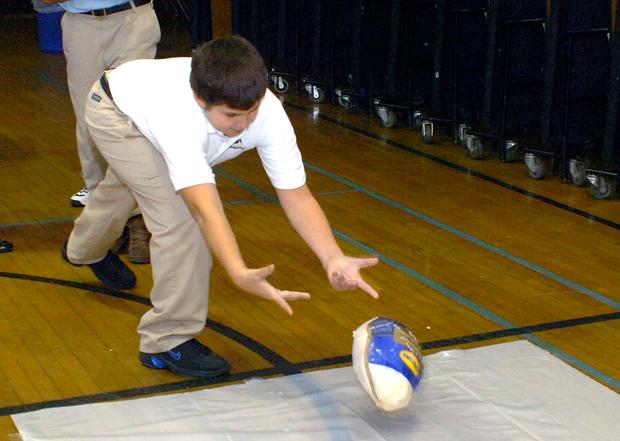Roasting a frozen bird can produce a better turkey.
And many food safety types agree.
Elizabeth Weise of USA Today writes the technique involves a hot oven, an icy bird and six hours to hang out with your relatives.
While the technique turns out not to be new, it’s gaining traction because of a Web publication outlining how to do it by Pete Snyder of the Hospitality Institute of Technology and Management, which does safety training for food companies.
"The breast is still moist and the dark meat is still tender," Snyder says from his office in St. Paul. It’s also excellent for food safety "because you didn’t drip that nasty turkey juice on everything in  the refrigerator for four days."
the refrigerator for four days."
Donald Schaffner, a food microbiologist at Rutgers University in New Brunswick, N.J., says from a safety perspective Snyder’s right. "A frozen turkey is going to spread less contamination around your kitchen than a thawed turkey."
Snyder tested the technique because "I had been one of those people that had woken up at 7:30 in the morning and the turkey was still frozen." But being a food-safety professional, he decided to throw in a few temperature-measuring thermocouplers.
He placed them at various points on multiple frozen turkeys as they roasted. What was happening in the oven, he found, was "the first half of the cooking period thaws the turkey and then the second half roasts it," he says.
His technique is simple:
Take one frozen turkey, 12 to 13 pounds.
Place a low wire rack on a cookie sheet with low sides.
Remove the plastic cover from the turkey.
Put the turkey on the rack.
Put it in a 325-degree oven.
Wait 4½ to five hours.
Eat.
Snyder recommends using a cookie sheet or another baking sheet with a low rim, not a high-sided roasting pan. "You want the hot oven air to evenly circulate all around the turkey," he says.
He also recommends putting the turkey on a rack on the pan so that the hot air can circulate underneath, as well.
The U.S. Department of Agriculture’s food-safety experts agree with Snyder. Kathy Bernard of USDA’s Meat and Poultry Hotline says "you can cook a turkey from a frozen state, the only thing you need to know is that it takes one and a half times longer to cook" than a thawed bird.
The technique is well known to the folks on the Butterball Turkey Talk-line. They get "lots" of calls on the topic Thanksgiving morning, says Carol Miller. She has been answering frantic questions for 27 years out of the Naperville, Ill., office.
The ideal final temperatures for the turkey is 160 degrees at the breast and 185 for the legs. But Snyder doesn’t think a thermometer is necessary because you can tell when the leg has reached  185 because "it will wiggle back and forth really easily" because the connective tissues will have begun to dissolve at that temperature, he says.
185 because "it will wiggle back and forth really easily" because the connective tissues will have begun to dissolve at that temperature, he says.
USDA isn’t so keen on the "wigging the leg" method of testing for doneness. "You need to use your food thermometer, you need to make sure the turkey should register 165 in the innermost part of thigh and the thickest part of the breast," Bernard says.
Butterball’s Miller says this is the time to canvass the neighborhood. "You really need a meat thermometer. If you don’t have one, give a guest a call and see if they can bring one. Or go to a convenience store. Or knock on a neighbor’s door."
The one area where Snyder and other turkey experts differ is on the matter of the neck and giblets, which in most commercially prepared turkeys will be placed in the neck and body cavity.
Snyder says that after about 2½ to three hours the turkey will have thawed enough that you can "carefully" pull them out of the warming bird to start to make stock. "You can leave them in, but then you don’t have them for the gravy," he says.
Butterball’s Miller disagrees. The bag they come is "designed to go through that heating process, so that’s not a problem." Trying to remove a slippery bag tucked deep in a turkey straight out of a hot oven — especially when everyone’s stressed about getting things done on time — just isn’t necessary. "They’re just as happy staying right where they are. That’s our recommendation and we’ve been doing this for 30 years."
The one thing you can’t do with a frozen turkey is deep fry it, because the frozen liquid can cause the oil to boil over, Snyder says. "That would be very, very dangerous."
